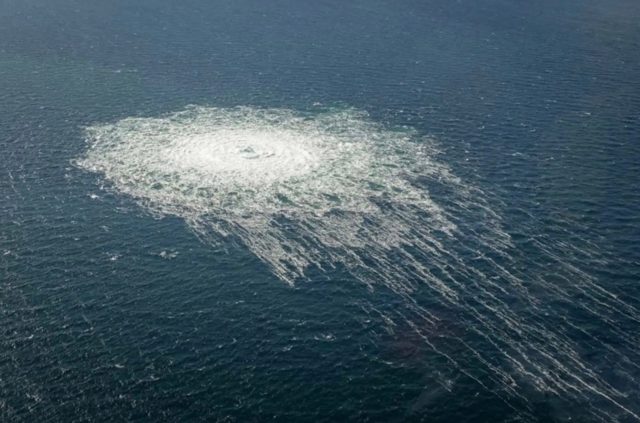
The US has long opposed NATO’s (especially Germany’s) dependence on Russian, formerly Soviet, natural gas. The United States, in fact, used export controls to block the original Yamal pipeline in the 1980s, believing the threat of a Russian cutoff would alter Europe’s political decisions.
As recently as 2018, then-president Donald Trump warned the Europeans at the UN General Assembly of the potential for a Russian energy cutoff. There is video of the German delegation to UNGA appearing to mock Mr. Trump. Then came Ukraine and severe cutbacks in the delivery of Russian natural gas to Europe.
Now, as Norway and Poland announce the opening of the Trans Baltic Pipeline, Russia’s Nord Stream 1 and Nord Stream 2 pipelines have been damaged near the Danish island of Bornholm in the Baltic Sea. Three separate pipeline breaches are apparent, essentially ruling out the possibility of a technical fault.
While the pipelines are not currently operating, they are kept filled with natural gas under pressure and the gas is bubbling up to the surface. This suggests the damage to both pipelines was significant, although a full assessment remains to be done.
Repairs, it appears, will take some time even if priority is given to the first Nord Stream pipeline, making it unlikely that it can be returned to service before winter, even if there is a change in the political situation.
The first guesses have been that the Nord Stream pipelines were sabotaged in an effort to affect Russia’s war in Ukraine. Such an operation would require the ability to locate the pipelines and place explosive charges in three different places. If they were, the questions are who did it and why?
The Nord Stream pipelines are at sea depths ranging from 80 to 110 meters (262 to 360 feet). Frogmen typically operate at 6 meters (20 feet), so submersible vehicles would have been needed to place explosives on the pipeline or otherwise damage it.
The underwater pipes for Nord Stream are made of steel grade DNV grade SAWL 485 (similar to grade X70) for wall thicknesses ranging from 26.8 to 34.4mm and were manufactured by six qualified producers (one in Russia, four in Europe and one in Japan). The pipes are encased in concrete.
Deliberate damage would be no easy matter. Ukraine has already said the sabotage was carried out by the Russians.
“The large-scale gas leak is nothing more than a terrorist attack planned by Russia and an act of aggression toward the EU,” Kiev’s presidential advisor Mikhaylo Podolyak announced on Twitter.
The trouble with that argument is that Russia would lose all its leverage with Europe if it destroyed its own pipelines. Both Nord Stream 1 and Nord Stream 2 are owned in a joint project. Gazprom has 51% and four Western partners: PEGI/E.ON and Wintershall Dea have 15.5% each, and French Engie and Dutch Gasunie 9% each.
Ukraine, itself, could be a candidate in an attempt to damage Russia economically, now and in the future. But if that is the case and Ukraine is discovered as the culprit, its relations with Europe and NATO would be tremendously damaged.
Almost every European country has the technical ability to operate offshore with remotely piloted vehicles and some of them have evolved underwater military services (like the US Navy SEALS), which can attack and destroy underwater targets. But which European country would want to do so?
It would be very risky for any European state to carry out a sabotage operation against the two pipelines. First, just as the Russians need Nord Stream 1 and Nord Stream 2 intact for their own reasons, the Europeans need them intact for future gas deliveries. In addition, such a move could be regarded by Russia as an act of war.
However, there are a few possible exceptions. Finland is in a serious dispute with Russia that started with Finland’s decision to join NATO. In May, Russia cut off gas supplies to Finland and earlier Russia halted electricity deliveries.
But it is hard to understand why Finland might consider the Nord Stream pipelines as a target for any retaliation. Finland itself has embargoed Russian coal and oil.
Russia also has a very tense relationship with the Baltic States, and any one of them could carry out sabotage acts against the Nord Stream pipelines. However, the fact that this would deprive Europe of gas deliveries in the near future, supposing an end of sanctions, makes this an unlikely move for any country that depends on NATO for security.
Could the US have sabotaged the Nord Stream pipelines to remove President Vladimir Putin’s leverage over Europe this winter?If there was substantial fear in Washington that Europe might break consensus on sanctioning Russian over the Ukraine war to save itself from an energy crisis this winter, then there could be logic in such a move – but also huge political, strategic and security risks.The US has become an important energy player sending LNG to Europe in ever-increasing quantities. Europe has been using US-supplied LNG to help fill its storage tanks for the coming winter.Most American deliveries go through France, with Spain and the Netherlands as secondary routes. There are reports that the US is almost at capacity in delivering LNG to Europe and Asia, and natural gas prices in the US could increase significantly if more LNG is shipped.No one can answer the question of who sabotaged the Nord Stream pipelines. If anything, though, the apparent sabotage of the pipelines demonstrates Europe’s irresponsibility in accepting gas from a known enemy – the fact that they got away with it for 37 years, in retrospect, is amazing.

